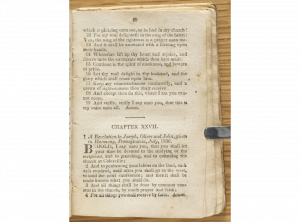Historical Context and Background of D&C 26
Brief Synopsis by Steven C. Harper
Joseph and the Saints in southern New York endured a blast of persecution in the summer of 1830. The Knight family in Colesville were understandably anxious. Back home in the nearby but comparatively peaceful setting of Harmony, Pennsylvania, Joseph received a series of revelations, including section 26. The Lord gave it to Joseph, Oliver Cowdery, and John Whitmer to teach them what to do until the conference scheduled for September in Fayette, New York.
The revelation says simply that Joseph and his brethren are to devote their time to scripture study, preaching, confirming the Saints in southern New York, and farming as needed until time for conference later in the summer. There he will direct them further.
The most significant, if understated, aspect of the revelation is the line “all things shall be done by common consent in the church, by much prayer and faith” (D&C 26:2). The Lord had revealed this principle earlier, but that revelation is not canonized, so this is the first mention of common consent in the Doctrine and Covenants. Joseph’s manuscript history says that before the Church was organized, the Lord commanded him and Oliver to ordain each other elders in the Church of Jesus Christ and then ordain others, but only after they could gather all who had been baptized to get “their sanction” and be “accepted by them as their teachers.”1
At that meeting, the members of the Church, the women and men, accepted Joseph and Oliver as their leaders by a unanimous vote.2 Though the word vote is used, common consent differs from a democratic election. In common consent, Church leaders put forward a proposal and ask for consent and dissent. Though consent is common, it is not taken for granted and dissent is to be respected. The presiding authority meets with a dissenting member to learn why they dissented and acts accordingly. In an unusual turn of events, Joseph Smith dissented in October 1843 at the proposal that Sidney Rigdon be sustained as his counselor in the First Presidency. Joseph’s dissent was overruled by the Church after a lengthy discussion.3
Newel Knight said section 26 provided
great consolation to the little band of Brethren and Sisters at Colesville after having been abandoned from time to time by the servants of God in consequence of the wicked who were constantly seeking to destroy the work of God from the earth. It showed us that the Lord took cognizance of us and also that he knew the acts of the wicked. So we resolved to continue steadfast in the faith and were diligent in our prayers and assembling ourselves together, waiting with patience until we should have the pleasure of again seeing Brother Joseph and others of the Servants of the Lord who had become dear to us by the ties of the gospel, and of being confirmed members of the Church of Jesus Christ by the laying on of hands of the Apostles.4
1. “History, circa June–October 1839 [Draft 1],” p. [8], The Joseph Smith Papers, accessed July 23, 2020.
2. “History, circa June–October 1839 [Draft 1],” p. [9], The Joseph Smith Papers, accessed July 23, 2020.
3. “History, 1838–1856, volume E-1 [1 July 1843–30 April 1844],” p. 1747-1749, The Joseph Smith Papers, accessed July 23, 2020.
4. Newel Knight, Autobiography and Journal, 1846, Church History Library, Salt Lake City.
Additional Context by Casey Paul Griffiths
From Doctrine and Covenants Minute
This revelation addresses Joseph Smith’s need for temporal support after the busy time involved in translating the Book of Mormon and organizing the Church. Even after the Church was organized, much of Joseph’s time was consumed traveling between the different branches of the Church in New York and Pennsylvania. At the time Joseph and Emma were living on a small thirteen-acre plot of land they had offered to purchase from Emma’s father, Isaac Hale. Because of his pressing responsibilities to the new Church, Joseph was unable to devote much time to farming the land, and Isaac began putting pressure on Joseph to pay the two hundred dollars he had promised for the land. Joseph was eventually able to pay off the debt in the month following the revelation, though Isaac remained skeptical of his son-in-law’s prophetic calling and ability to take care of his daughter. The revelation instructed Joseph to continue his labors among the Saints but also see to his temporal labors.
See Historical Introduction, “Revelation, July 1830–B [D&C 26],” p. 34, The Joseph Smith Papers, accessed November 5, 2020, https://www.josephsmithpapers.org/paper-summary/revelation-july-1830-b-dc-26/1


